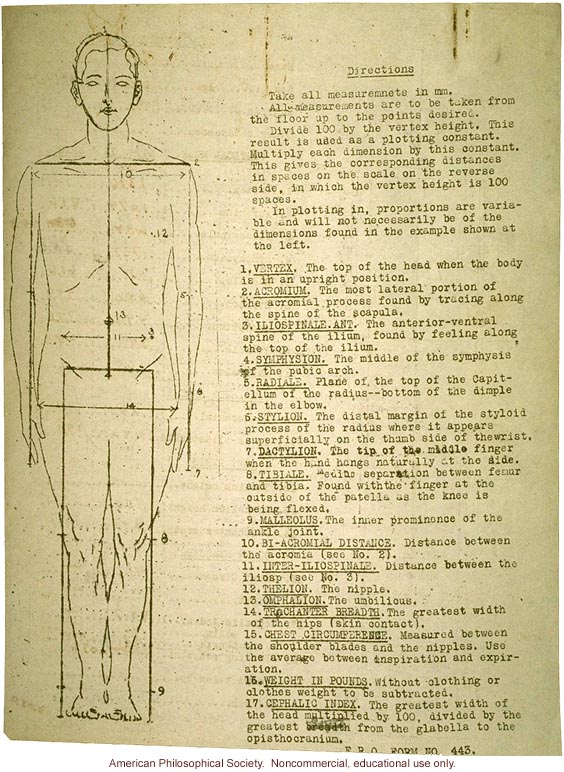[artwork - diagram of human male]
Directions
Take all measurements in mm.
All measurements are to be taken from the floor up to the points desired.
Divide 100 by the vertex height. This result is used as a plotting constant.
Multiply each dimension by this constant. This gives the corresponding distances in spaces on the scale on the reverse side, in which the vertex height is 100 spaces.
In plotting in, proportions are variable and will not necessarily be of the dimensions found in the example shown at the left.
1. Vertex. The top of the head when the body is in an upright position.
2. Acromium. The most lateral portion of the acromial process found by tracing along the spine of the scapula.
3. Iliospinale Ant. The anterior-ventral spine of the ilium, found by feeling along the top of the ilium.
4. Symphision. The middle of the symphysis of the pubic arch.
5. Radiale. Plane of the top of the Capitellum of the radius - bottom of the dimple in the elbow.
6. Stylion. The distal margin of the styloid process of the radius where it appears superficially on the thumb side of the wrist.
7. Dactylion. The tip of the middle finger when the hand hangs naturally at the side.
8. Tibiale. Medius[sp.?] separation between femur and tibia. Found with the finger at the outside of the patella as the knee is being flexed.
9. Malleollus. The inner prominence of the ankle joint.
10. Bi-Acromial Distance. Distance between the acomia (see No. 2).
11. Inter-Iliospinale. Distance between the iliosp (see No. 3).
12. Thelion. The nipple.
13. Omphalion. The umbilious.
14. Trachanter Breadth. The greatest width of the hips (skin contact).
15. Chest circumference. Measured between the shoulder blades and the nipples. Use the average between inspiration and expiration.
16. Weight in pounds. Without clothing or clothes weight to be subtracted.
17. Cephalic index. The greatest width of the head multiplied by 100, divided by the greatest [obscured] from the glabella to the opistocranium.
FPO form no. 443.


